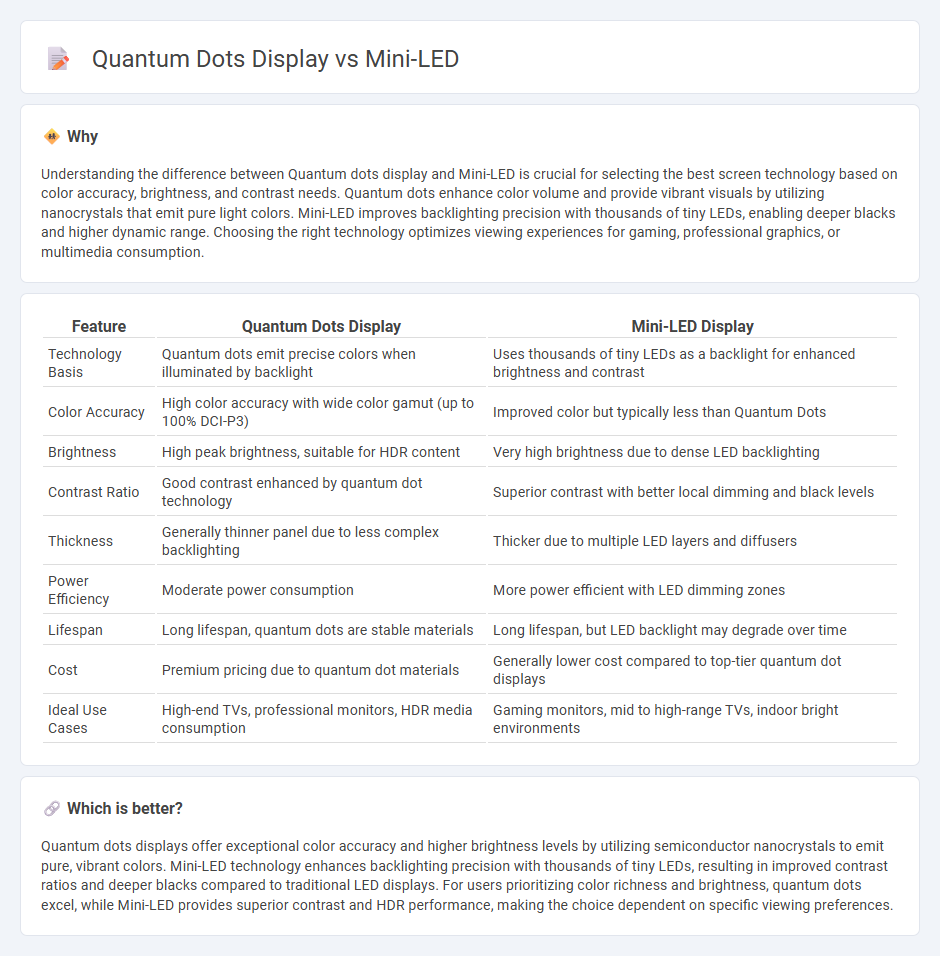
Quantum dots displays utilize semiconductor nanocrystals that emit precise light wavelengths, resulting in vibrant colors and improved energy efficiency. Mini-LED technology employs thousands of tiny LEDs for backlighting, offering enhanced brightness and deeper contrast than traditional LED displays. Explore the differences between these cutting-edge display technologies to determine which suits your needs best.
Why it is important
Understanding the difference between Quantum dots display and Mini-LED is crucial for selecting the best screen technology based on color accuracy, brightness, and contrast needs. Quantum dots enhance color volume and provide vibrant visuals by utilizing nanocrystals that emit pure light colors. Mini-LED improves backlighting precision with thousands of tiny LEDs, enabling deeper blacks and higher dynamic range. Choosing the right technology optimizes viewing experiences for gaming, professional graphics, or multimedia consumption.
Comparison Table
| Feature | Quantum Dots Display | Mini-LED Display |
|---|---|---|
| Technology Basis | Quantum dots emit precise colors when illuminated by backlight | Uses thousands of tiny LEDs as a backlight for enhanced brightness and contrast |
| Color Accuracy | High color accuracy with wide color gamut (up to 100% DCI-P3) | Improved color but typically less than Quantum Dots |
| Brightness | High peak brightness, suitable for HDR content | Very high brightness due to dense LED backlighting |
| Contrast Ratio | Good contrast enhanced by quantum dot technology | Superior contrast with better local dimming and black levels |
| Thickness | Generally thinner panel due to less complex backlighting | Thicker due to multiple LED layers and diffusers |
| Power Efficiency | Moderate power consumption | More power efficient with LED dimming zones |
| Lifespan | Long lifespan, quantum dots are stable materials | Long lifespan, but LED backlight may degrade over time |
| Cost | Premium pricing due to quantum dot materials | Generally lower cost compared to top-tier quantum dot displays |
| Ideal Use Cases | High-end TVs, professional monitors, HDR media consumption | Gaming monitors, mid to high-range TVs, indoor bright environments |
Which is better?
Quantum dots displays offer exceptional color accuracy and higher brightness levels by utilizing semiconductor nanocrystals to emit pure, vibrant colors. Mini-LED technology enhances backlighting precision with thousands of tiny LEDs, resulting in improved contrast ratios and deeper blacks compared to traditional LED displays. For users prioritizing color richness and brightness, quantum dots excel, while Mini-LED provides superior contrast and HDR performance, making the choice dependent on specific viewing preferences.
Connection
Quantum dots displays utilize nanoscale semiconductor particles to emit precise colors, enhancing color accuracy and brightness in screens. Mini-LED technology involves thousands of small LEDs as backlight units, improving contrast and local dimming capabilities in displays. Combining quantum dots with Mini-LED backlighting results in highly efficient displays with superior color gamut, brightness, and contrast ratios, ideal for advanced TVs and monitors.
Key Terms
Backlighting
Mini-LED technology utilizes thousands of tiny LEDs as a precise local dimming backlight, significantly enhancing contrast and brightness compared to traditional LED displays. Quantum dot displays leverage a film of semiconductor nanocrystals to convert backlight into pure, vibrant colors with high color accuracy and brightness. Discover the intricacies and benefits of these backlighting technologies to choose the best display for your needs.
Color gamut
Mini-LED displays offer enhanced backlighting control, resulting in higher contrast ratios and deeper black levels, which contribute to a better overall color performance. Quantum dots technology delivers a wider color gamut and more precise color reproduction by emitting pure and vibrant light when illuminated by an LED backlight. Explore the differences in color accuracy and vividness between these two display technologies to determine which suits your viewing preferences best.
Local dimming
Mini-LED technology enhances local dimming by utilizing thousands of tiny LEDs as backlight zones, providing precise control over brightness and contrast for deeper blacks and vibrant colors. Quantum dots improve color accuracy and brightness through nanocrystals that emit specific wavelengths of light when illuminated, but their local dimming depends on the backlighting system used, often paired with Mini-LED or traditional LED arrays. Explore the nuances of local dimming and color performance to discover which display technology best suits your viewing needs.
Source and External Links
What is mini-LED? The TV display tech explained - Mini-LED is a more efficient backlighting technology for LCD screens using smaller LED diodes to allow more precise backlight control, resulting in better brightness, stronger contrast, and less backlight bleed that approaches OLED performance without OLED's degradation issues.
TCL 65" QM8K Series QD-Mini LED QLED 4K UHD Smart TV - TCL's QD-Mini LED technology combines QLED and Mini LED for pixel-level backlight precision with ultra-high brightness, enhanced contrast, and deep blacks using advanced lens and light control algorithms to eliminate halo effects and improve picture quality.
The 4 Best Mini LED TVs of 2025 - Mini LED TVs have many more local dimming zones than traditional LED TVs, allowing for precise control with less blooming and deeper blacks, with models like the Sony BRAVIA 9 QLED offering near-OLED level HDR performance and excellent reflection handling.
 dowidth.com
dowidth.com